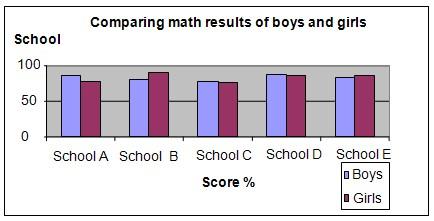| Complexity level: | 5 |
| Project cost ($): | 20 |
| Time required: | Preparation will take approximately one day, and observation and recording of data will require another day. |
| Material availability: | Easily found |
| Safety concerns: | Basic safety requirements |
Hypothesis
Boys perform better than girls when solving mathematical problems.
Overview
Comparing math performance in boys and girls
Boys have always been believed to be better than girls in their ability to solve mathematical problems - this could be due to the fact that there are more men than women in professions that require mathematical analytical skills, such as engineers, physicists and mathematicians.
The fact that boys perform better than girls in situations that require mathematical analytical reasoning has been proven statistically. However, it is still debatable whether a male’s ability to perform better at math, is due to nature or nurture. When the statistical results were narrowed down to countries with predominant cultures that had no particular gender preferences, it was discovered that the gap in the performance of boys and girls in mathematics examinations narrowed.
Scientific Terms
Materials
Materials required for this science fair project:
- 50 boys 15 years of age – 10 boys from 5 different schools
- 50 girls 15 years of age – 10 girls from 5 different schools
- 100 copies of a math exam paper
- 1 set of answers for the exam
- 1 examination hall for the 100 students
Procedure
1. The independent variable for this science fair project is the gender of the students sitting for the math exam. The dependent variable is the average scores of the students, which is determined by marking and grading the mathematics examination papers, and calculating the average scores of the students according to their school and gender. The constants (control variables) are the age of the students and the difficulty of the math paper.
2. Choose five secondary co-ed schools for this experiment and ask their respective principals for permission to invite their best math students to participate in this study. Invite ten boys and ten girls from each school.
3. Prepare 100 sets of mathematics examination papers, together with the model answers for marking and grading the papers.
4. On the day of the exam, lead the 100 participants into the examination hall and instruct them to sit at their tables. Distribute the examination papers and give the students two hours to complete the paper. After two hours, collect the answer scripts.
5. Create the answer script by comparing against the model answers. Calculate the average results of each gender from each school using the formulae below:
Average math results for boys = (Sum of results for 10 boys)/10
Average math results for girls = (Sum of results for 10 girls)/10
6. Record the average results for each gender and school in the table given below.

Results
The average performance of both genders in the mathematics examination was observed to be approximately the same. The boys performed better by only 0.2%.
| Gender | Average math scores of boys and girls from 5 schools (%) | Average % | ||||
| School A | School B | School C | School D | School E | ||
| Boys | 86 | 81 | 78 | 88 | 83 | 83.2 |
| Girls | 77 | 89 | 76 | 86 | 87 | 83 |
Use the graph below to plot the experimental data recorded in the table above.

Conclusion
The experimental data and analyzed results do not support the hypothesis that boys perform better than girls when solving mathematical problems.
Why are girls perceived to be weaker at math in some countries? It is believed to be a result of gender inequality that still exists in some countries, where girls are not given the same opportunity as boys to attend school. However, in first world countries such as the USA and other European countries, where both genders are given equal schooling opportunities, female students have been observed to be as good as male students at math. As such, the gender gap in mathematical abilities is probably a result of nurture instead of nature.
Also consider
This science fair project may be repeated on students of different age groups.
Try to repeat the experiment by comparing the math "gender gap" among students from schools in the city vs schools located in rural areas/the country.
References
Are boys better than girls at math? - http://www.spring.org.uk/2008/07/are-boys-better-than-girls-at-maths.php
Boys not better than girls at math – study finds - http://www.guardian.co.uk/education/2008/may/30/schools.uk1

